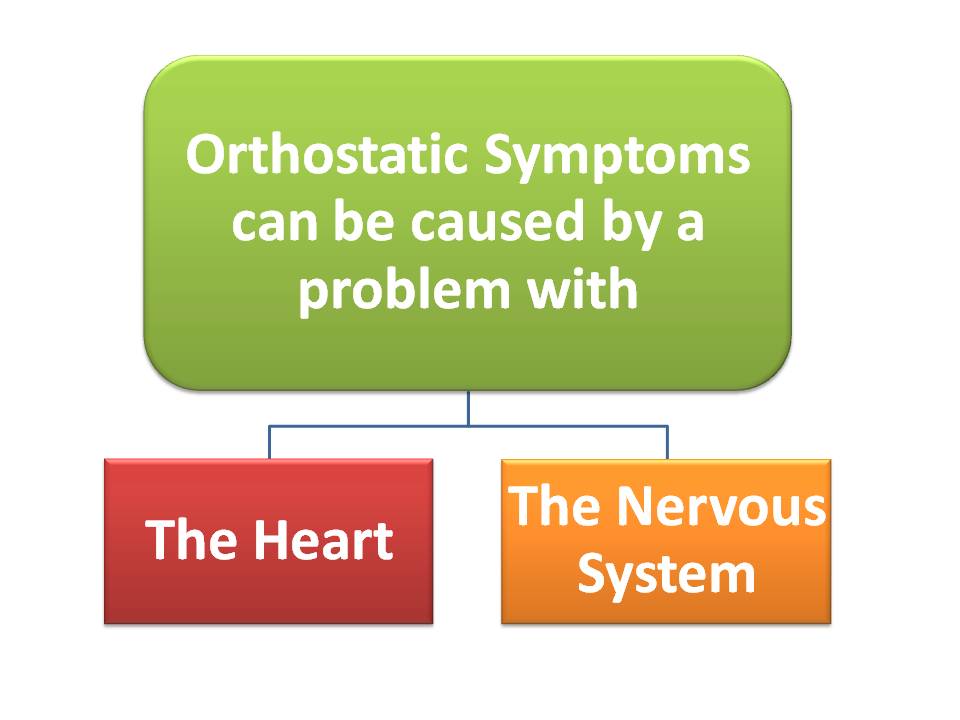Causes of Orthostatic Intolerance (OI) Conditions
"Orthostatic Intolerance" is not a medical condition or a diagnosis. When someone has Orthostatic Intolerance (OI), it means they have symptoms that are common to people who have a problem when they stand up. It can be caused by many different conditions and it can be caused by different problems in the body. (Sometimes, physicians might say you have this when they know you have the symptoms but they don't know which type of OI you have or the cause.
Cause of Orthostatic Symptoms with Standing (or Sitting Up)

Orthostatic symptoms with standing up can be caused by conditions with the heart or the nervous system.
The Heart - The pages on Fainting talk about the ways the heart can cause fainting and orthostatic problems.
The Nervous System - Low blood pressure and fast heart rate are more often caused by a problem with the nervous system, specifically, the autonomic nervous system (ANS), and how it is communicating information to the heart and blood vessels.
• To find out more about the ANS causes of OI, start with Causes - due to the Autonomic Nervous System (dysautonomia)
• To find out more about the types of OI conditions, like orthostatic hypotension (OH), NMH and POTS, start with Types of Orthostatic Intolerance (OI)
Combination of the heart and nervous system changes - When a person has had time of prolonged bedrest (or repeat periods of long bedrest), the body adapts itself so that lying down becomes 'normal'. The changes start within the first 48 hours and continue for days and weeks. The changes affect all the body systems: they start in the muscles, especially the heart, within 48 hours. These changes are called "deconditioning".
They can create a second reason a person develops problems with standing up or sitting after they have had a prolonged illness. Because of the attention they have been getting recently, the information about prolonged bedrest and deconditioning is in a separate section - Deconditioning?!!.
How to tell where the problem is coming from - Diagnosis addresses what is done to tell if the problem is coming from the heart or the nervous system.
The Orthostatic Intolerance Center provides limited information about the causes of OI due to heart conditions. They are usually diagnosed and treated by Cardiologists.
References
- Strickberger SA, Benson DW, Biaggioni I, Callans DJ, Cohen MI, Ellenbogen KA, et al. AHA/ACCF Scientific statement on the evaluation of syncope. Circulation. 2006;113:316–327
- Moya A, Sutton R, Ammirati F, Blanc JJ, Brignole M et al., Guidelines for the diagnosis and management of syncope (version 2009). European Heart Journal (2009); 30: 2631-2671.
- Brignole M. Diagnosis and Treatment of Syncope. Heart 2007: 93; 130-136. Article PDF
- Stewart JM, Medow MS, Alejos JC. Orthostatic Intolerance. Medscape article.
- Grubb BP. Postural tachycardia syndrome. Circulation. 2008;117:2814–2817. Abstract. Article PDF.
- Thieben MJ, Sandroni P, Sletten DM, et al. Postural orthostatic tachycardia syndrome: The Mayo Clinic experience. Mayo Clin Proc. 2007;82:308–313.
Author: Kay E. Jewell, MD
Page Last Updated: August 12, 2012
